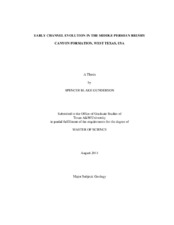| dc.contributor.advisor | Tice, Michael M. | |
| dc.creator | Gunderson, Spencer | |
| dc.date.accessioned | 2011-10-21T22:03:41Z | |
| dc.date.accessioned | 2011-10-22T07:12:05Z | |
| dc.date.available | 2011-10-21T22:03:41Z | |
| dc.date.available | 2011-10-22T07:12:05Z | |
| dc.date.created | 2011-08 | |
| dc.date.issued | 2011-10-21 | |
| dc.date.submitted | August 2011 | |
| dc.identifier.uri | https://hdl.handle.net/1969.1/ETD-TAMU-2011-08-9710 | |
| dc.description.abstract | Submarine channels are important conduits for sediment in deep marine environments, and understanding their formation is critical to modeling basin fill processes. Most models describing channel evolution focus on turbidity currents as the erosive and constructive force in channel initiation. However, slope failure and slumping can be significant drivers of channelization, particularly in upper slope and ramp environments. Determining the relative roles of slumping and erosion by turbidity currents can provide important insight into the timing of channelization and the geometries of subsequent deposits. Samples were collected from Guadalupe Mountains National Park from two primary localities at Salt Flat Bench (Figure 2). Three vertical sections were measured at both locations. A total of 16 samples were collected for petrographic analysis and X-ray fluorescence (XRF) imaging.
Spectacular outcrop quality makes the Middle Permian Brushy Canyon Formation in Guadalupe Mountains National Park an ideal location for the study of early channel evolution. A detailed facies analysis of fine-grained channel deposits was conducted in the Upper Brushy Canyon Formation in the Salt Flat Bench outcrops. After channelization, an interval of relative condensation dominated by hemipelagic settling of organic matter and silt was followed by an interval of incomplete sediment bypass by turbidity currents. This sequence of events suggests that sea level was at a relative highstand at the time of channel inception, whereas channel inception by turbidity currents is expected during a lowstand. Slumping rather than erosion by turbidity currents is the most likely mechanism to have initiated a channel at the study area. There is no evidence for the existence for high energy currents until after the interval of condensation. However, the action of weak contour currents during early channel evolution is observed in outcrop and microtextural features. Early carbonate cementation of channel-lining silts may have stabilized the slump surface with respect to erosion by later turbidity currents. | en |
| dc.format.mimetype | application/pdf | |
| dc.language.iso | en_US | |
| dc.subject | Brushy Canyon | en |
| dc.subject | Turbidity Currents | en |
| dc.subject | Condensation | en |
| dc.subject | Submarine Channel | en |
| dc.subject | Bypass | en |
| dc.title | Early Channel Evolution in the Middle Permian Brushy Canyon Formation, West Texas, USA | en |
| dc.type | Thesis | en |
| thesis.degree.department | Geology and Geophysics | en |
| thesis.degree.discipline | Geology | en |
| thesis.degree.grantor | Texas A&M University | en |
| thesis.degree.name | Master of Science | en |
| thesis.degree.level | Masters | en |
| dc.contributor.committeeMember | Ayers, Walter | |
| dc.contributor.committeeMember | Weiss, Robert | |
| dc.contributor.committeeMember | Olszewski, Thomas | |
| dc.type.genre | thesis | en |
| dc.type.material | text | en |


